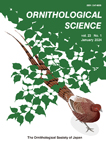最新号
選択された号の論文の7件中1~7を表示しています
- |<
- <
- 1
- >
- >|
EDITORIAL
-
原稿種別: EDITORIAL
2024 年 23 巻 1 号 p. 1
発行日: 2024年
公開日: 2024/01/29
PDF形式でダウンロード (100K)
ORIGINAL ARTICLE
-
原稿種別: ORIGINAL ARTICLE
2024 年 23 巻 1 号 p. 3-12
発行日: 2024年
公開日: 2024/01/29
PDF形式でダウンロード (954K) -
原稿種別: ORIGINAL ARTICLE
2024 年 23 巻 1 号 p. 13-20
発行日: 2024年
公開日: 2024/01/29
PDF形式でダウンロード (3322K)
SHORT COMMUNICATION
-
原稿種別: SHORT COMMUNICATION
2024 年 23 巻 1 号 p. 21-26
発行日: 2024年
公開日: 2024/01/29
PDF形式でダウンロード (794K) -
原稿種別: SHORT COMMUNICATION
2024 年 23 巻 1 号 p. 27-33
発行日: 2024年
公開日: 2024/01/29
PDF形式でダウンロード (1691K) -
原稿種別: SHORT COMMUNICATION
2024 年 23 巻 1 号 p. 35-43
発行日: 2024年
公開日: 2024/01/29
PDF形式でダウンロード (679K) -
原稿種別: SHORT COMMUNICATION
2024 年 23 巻 1 号 p. 45-49
発行日: 2024年
公開日: 2024/01/29
PDF形式でダウンロード (560K)
- |<
- <
- 1
- >
- >|
